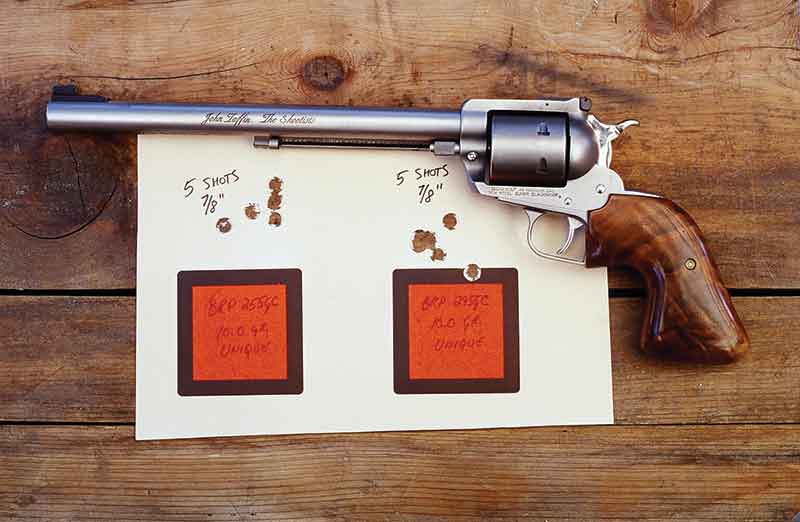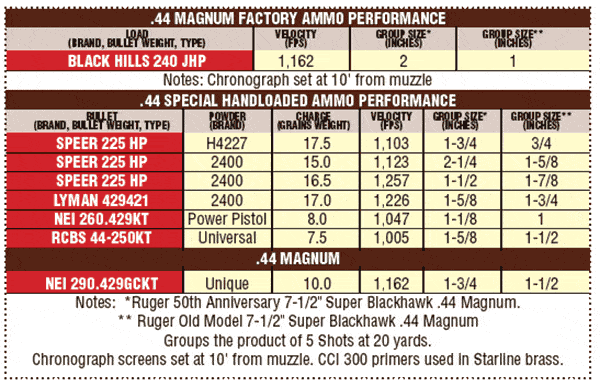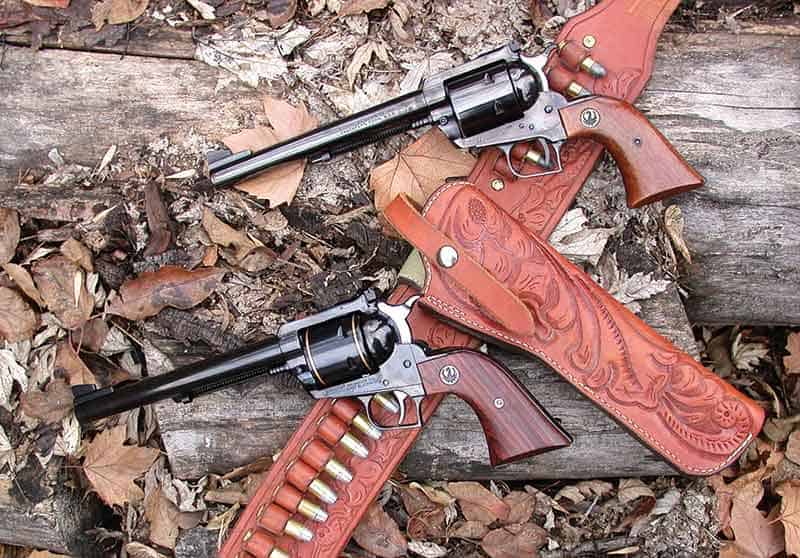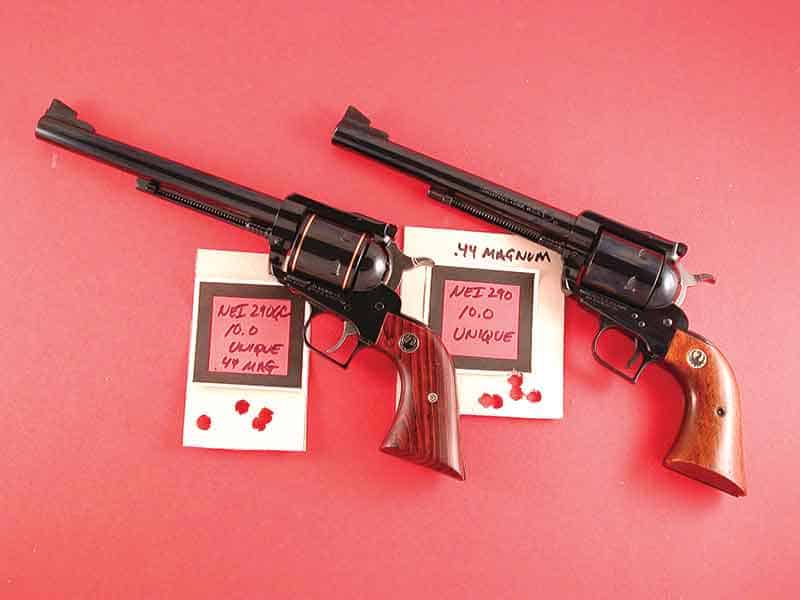That wonderful year was 1959. Ike was in the White House, Hawaii and Alaska became states, and Charlton Heston won Best Actor for Ben Hur, which was also chosen for Best Film. Sports fans watched the Colts beat the Giants for the NFL championship and in the World Series the Dodgers beat the White Sox. Walt Disney’s Mickey Mouse Club went off the air, a young actor by the name of Clint Eastwood arrived as Rowdy Yates in the TV series Rawhide, and for Western fans Saturday night television was ruled by Paladin and Matt Dillon.
It was 6-degrees below zero on a February morning when this then young teenager and an even younger teenager now known as Diamond Dot crossed over the state line in a 1954 Chevy to be married. Yes, 1959 is definitely a year to be remembered.
Both the original .357 and .44 Magnum Blackhawks are now known to collectors as Flat-Tops. In many parts of the country Ruger’s .44 Magnum arrived on dealer shelves even before the Smith & Wesson .44 Magnum. A group of us teenagers, I was 17 at the time, used to gather every Saturday afternoon at Boyle’s Gun Shop or Shell’s Gun and Archery Farm to shoot. Both establishments had outdoor ranges and when one is young weather makes no difference, so we shot almost every week. Shell’s received an early 4″ Smith & Wesson .44 Magnum and he rented it out along with six rounds of ammunition. Each one of us shot it in turn. The recoil was awful, however we all lied and said it wasn’t bad; after all, teenagers are supposed to be invincible.
That experience was not easy to forget so when the first Ruger .44 Blackhawk arrived I bought it instead of a Smith. It sold for $96 and I still have it more than a half-century later. It started as a standard 6-1/2″ Blackhawk, was soon cut to an easier carrying 4-5/8″ length, and then returned to the factory for a 7-1/2″ barrel when I needed the shorter length for a custom .44 Special Ruger. When his Esteemed Editorship pinned me to the wall several years back and forced me to pick my one favorite sixgun, it was this old Ruger. It was an easy choice.
The first time I shot that Ruger Blackhawk I found I had an even bigger and more ferocious tiger by the tail than that .44 Magnum Smith & Wesson. The experts at the time all seemed to think the Ruger would handle recoil better than the Smith as the grip frame was identical to the Colt Single Action Army, known for gently rocking in the hand under recoil. The problem was there was nothing gentle about the .44 Magnum. When I touched off that first round the .44 Ruger Blackhawk rotated more than 90-degrees backwards and the hammer dug a piece of skin out of the back of my hand. I went back to shooting the .44 Special and .45 Colt.
Eventually with more shooting experience I learned to handle both the S&W and Ruger .44 Magnums. However, my experience with the Ruger was apparently quite widespread and Ruger sought to alleviate the problem. The result in 1959 was the Ruger Super Blackhawk, with several changes. To add more weight the barrel was standardized at 7-1/2″ instead of the 6-1/2″, the cylinder was unfluted, and the grip frame was changed from aluminum alloy to a larger one of heavier steel.
To come up with the Super Blackhawk grip frame, Bill Ruger reached way back to the 1847 Colt Walker and Dragoon sixguns. These grip frames are not only longer than the original .44 Blackhawk grip, they also used a square-back triggerguard. Ruger also added a wide, checkered hammer spur and wide, grooved trigger to complete the package which was finished in a high polished bright blue. The original run of Super Blackhawks were packed in wooden boxes and sold for $120. When the boxes were no longer available the price was dropped to $116 at a time when the Smith & Wesson .44 Magnum was selling for $140.
I purchased my first Ruger Super Blackhawk in 1965 and still have it. I’ve carried it over many miles of Idaho’s sagebrush, foothills, forests and mountains, however I found I preferred the standard .44 Blackhawk with its smaller grip frame and which had been re-barreled to 7-1/2″. The Super Blackhawk was sent off to Larry Kelly at Mag-na-port for total customizing. The barrel was Mag-na-ported and cut back even with the ejector rod housing, the action was totally tuned, and the entire sixgun was finished in M-N-P’s satin nickel.
I have since replaced the Super Blackhawk grip frame with one from a stainless steel Ruger Old Army and also fitted Eagle’s Ultra-ivory grips. Most shooters find the Super Blackhawk grip quite comfortable, but the square back triggerguard raises havoc with my knuckle. This custom Super is now a major candidate for the title of Perfect Packin’ Pistol. I mostly use it with 260-grain Keith bullets over 10.0 grains of Unique or Universal for about 1,150 fps. This is a powerful load yet still kind to the shooter.
The original Ruger Super Blackhawk was only offered as an all blue, 7-1/2″ .44 Magnum. Today this Super Blackhawk is known to collectors as the Old Model or 3-Screw. It did not immediately replace the standard .44 Blackhawk and both were available until 1963. When Ruger switched from the Flat-Top configuration to the Blackhawk now known as the Old Model, 3-Screw with wings on both sides of the rear sight, the standard .44 Blackhawk was dropped from production. New Model Rugers are easily recognized by two things; the three screws on the side of the frame were replaced by two pins and the trigger sits much farther forward in the triggerguard.

Before Ruger introduced the New Model with a long barrel Taffin had this custom
satin nickel Super Blackhawk made by Trapper Gun. The scope is by Bushnell and
the stocks, Herrett’s Single Action Trooper model, solved Taffin’s problem of being
bitten by the square backed triggerguard of the Super Blackhawk.
Ruger’s New Model added a transfer bar safety allowing single actions to be safely carried hammer down with all chambers loaded under normal conditions. Traditional single action sixguns are loaded and unloaded by placing the hammer on half-cock, opening the loading gate, and rotating the cylinder; with the New Model action there is no half-cock notch on the hammer and simply opening the loading gate allows the cylinder to be rotated while the hammer remains in a down position.
With the coming of the New Model Blackhawks, the Super Blackhawk 7-1/2″ remained standard, however a longer 10-1/2″ barrel was soon offered for hunters and silhouetters. Both of these were all blue but were soon sided by stainless steel versions.
For nearly 30 years no factory produced short-barreled Super Blackhawks were available. This was corrected when the 5-1/2″ barrel length came along in 1987 and finally in 1994 both blued and stainless 4-5/8″ Packin’ Pistols in .44 Magnum were introduced. The shorter barreled versions are not easily recognized as Super Blackhawks as they are fitted with standard grip frames rather than the longer, square-backed Dragoon-style frames of the other Super Blackhawk barrel lengths.
In the late 1970s and early 1980s Diamond Dot and I were both competing in Long Range Silhouetting and, since we did not see sights the same way, I ordered a pair of 10-1/2″ Super Blackhawks so we could both easily keep track of our sight settings. For a secure grip during competition both were also equipped with Pachmayr rubber grips. By the time the Super Blackhawk arrived in stainless, we were no longer competing and I also found I had the most accurate Ruger .44 Magnum I had ever experienced. With its interchangeable post front sight, I found I shot it very well with iron sights and have used it for hunting, taking a record book Aoudad. With its long barrel and black sights I can still shoot this sixgun as well as any I own.
Ruger also offers the Hunter Model Super Blackhawk in stainless steel with a 7-1/2″ heavy ribbed barrel with cutouts to accept Ruger scope rings. It is offered with either the Bisley or Super Blackhawk grip frame with a rounded triggerguard. Without a doubt the Hunter Model Super Blackhawk is the greatest bargain offered today for handgun hunters.
Over the past 50 years I would guess the Ruger Super Blackhawk has been chosen by more handgun hunters and outdoorsmen than any other sixgun. Happy 50th Birthday and Golden Anniversary to Bill Ruger’s grand offering. Unless everything unravels in this country, and it certainly could, I expect 50 years from now these pages will contain the Centennial Salute to the Super Blackhawk.
The Ruger Super Blackhawk of 1959 gained immediate acceptance with shooters and especially handgun hunters. Commemorating that prestigious event of 50 years ago Ruger produced the 50th Anniversary Super Blackhawk for 2009. The Anniversary Model, except for the New Model transfer bar action, is the same basic .44 Magnum of 1959. The barrel length is 7-1/2″, the finish is bright blue, and the grips, instead of the original walnut, are a most attractive Cocobolo complete with a black eagle emblem and beautifully fitted to the frame.
It is obvious Ruger spent extra time on this model not only with fit and finish but also the fact that all cylinder chamber throats are a perfect and uniform .431″, the barrel/cylinder gap is .003″, and the trigger pull is set at 3-3/4 pounds. This Anniversary Model is also embellished with two gold bands around the cylinder as well as “50th ANNIVERSARY SUPER BLACKHAWK 2009” in gold lettering on the top of the barrel. All in all this is one of the nicest, perhaps the best crafted sixgun to ever come from the Ruger factory. Shooting this new Ruger Blackhawk was pure pleasure and also brought back many memories over the past half-century as I ran it alongside my nearly 50-year-old original Super Blackhawk.
Handgun: 50th Anniversary Super Blackhawk
Maker: Sturm Ruger
200 Ruger Road, Prescott, AZ 86301
www.ruger.com
Action Type: Single Action
Caliber: .44 Magnum
Capacity: 6
Barrel Length: 7-1/2″
Overall Length: 13-1/2″
Weight: 48 ounces
Finish: High gloss blue
Sights: Ruger adjustable rear,
ramp front
Grips: Cocobolo
Price: $880







